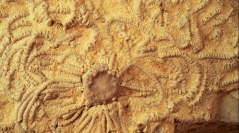

 European Journal of Taxonomy
729 (121) - Pages 121-137
European Journal of Taxonomy
729 (121) - Pages 121-137Most fossil feather stars are known only from the centrodorsal often connected to the radial circlet. This is the case for Discometra rhodanica (Fontannes, 1877), the type species of the genus Discometra, collected from the Late Burdigalian of the Miocene Rhône-Provence basin (southeastern France). The quarries operating in this area have exposed layers from the Late Burdigalian on the northern flank of the Lubéron anticline near Ménerbes (basin of Apt, Vaucluse, southeastern France). These layers contain exceptionally well-preserved echinoderms, among which are three specimens of a feather star with cirri and arms still connected to the centrodorsal. They are attributed to a new species: Discometra luberonensis sp. nov. (Himerometridae). The number of arms can reach 60, as in extant species of the genus Himerometra, but the pattern of arm divisions is closer to that of the genus Heterometra, which has no more than 45 arms in extant species. Discometra luberonensis sp. nov. differs from D. rhodanica by the characters of its centrodorsal. Here we redescribe the centrodorsal and radial circlets of D. rhodanica based on previously and newly collected specimens. We designate a neotype for D. rhodanica, because the holotype is considered lost. Affinities between Discometra, Himerometra and Heterometra are discussed.